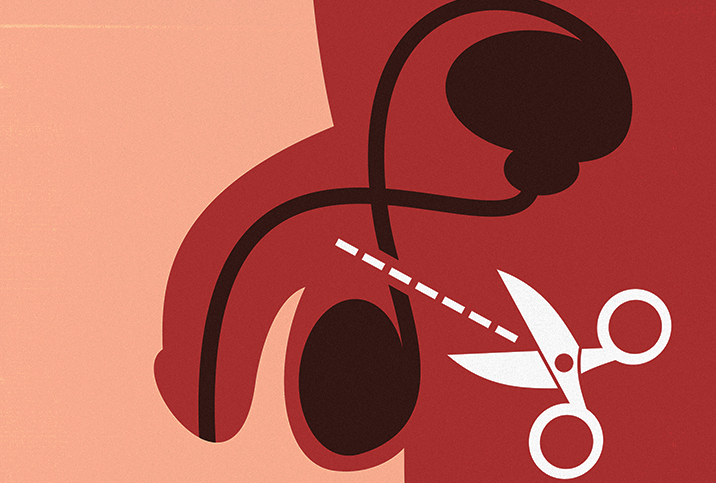Is a Vasectomy Right For You?

Men who are looking to share birth control responsibilities with a current partner or any future partners will eventually find it's time they consider a vasectomy. While the fertility consequences of a vasectomy are permanent, men's quality of life rarely diminishes after they get the surgery, as their ability to participate in sexual activity continues unhindered after recovery.
What is a vasectomy?
A vasectomy is a minimally invasive surgery performed under local anesthesia and carried out on an outpatient basis. The entire procedure takes about 15 minutes, and its purpose is to cut and tie, or seal, the vasa deferentia, which thereby prevents sperm from entering the ejaculatory ducts and becoming part of the semen. After the procedure, the man is still able to ejaculate but without sperm in the semen. The testes continue to create sperm, but with no way of being transported outside the body, it is absorbed.
Men have the option of two kinds of vasectomies: a conventional vasectomy and a no-scalpel vasectomy.
During a conventional vasectomy, the surgeon applies a local anesthetic to the scrotum to numb it and makes two cuts to reach the tubes, called the vas deferens, that connect the testicles to the pelvis. Both tubes are cut and a small section of them is removed. The ends of the tubes are then sealed, either by tying or searing them with heat. The surgeon then stitches up the scrotum with dissolvable stitches that disappear after about a week.
During a no-scalpel vasectomy, the surgeon also applies a local anesthetic to the scrotum, then gains access to the vas deferens with sharp dissectors, cuts the vas deferens, and uses heat cautery to burn the cut ends of the vas deferens closed. Though no scalpel is used to cut the scrotum, sutures can be involved because the dissector still opens the skin and there can be bleeding. Surgeons can also use dissolvable skin glue or compress the skin edges as an alternative. This method is considered to be less painful and less likely to involve any complications associated with a conventional vasectomy.
Everybody's doing it
Vasectomies are one of the most popular forms of birth control, with about 500,000 procedures carried out each year in the United States. Men generally choose a vasectomy due to the procedure's effectiveness, quickness and cost.
They are a highly effective permanent form of male contraception, but vasectomies are not 100 percent guaranteed. The risk of pregnancy after a vasectomy is about 1 in 2,000 for men who experience azoospermia following the procedure; however, it is a safe procedure that's both low risk and typically devoid of complications like heart disease and post-procedural effects.
Known as "the snip," vasectomy procedures typically allow patients to go home the same day, and post-procedure care includes oral pain medication and scrotal support care, such as bandages or tight-fitting underwear.
Men eventually return for a post-vasectomy semen analysis (PVSA), but sexual partners must use some form of contraception until the vas deferens occlusion is confirmed by the PVSA. In a determined amount of time after the procedure set forth by your doctor, the patient returns to the office to provide a semen sample, and if no motile sperm are detected, the procedure is deemed successful.
The long-term cost of a vasectomy is a prominent reason it's such a popular form of birth control. Over a 10-year span, a vasectomy costs an average of about $86 annually. For sexually active individuals, average annual costs for other forms of birth control include:
- Condoms: $168.91
- Cervical cap: $100
- Sponge: $2,000 to $4,000
- Oral contraceptives: $600
- Hysterectomy: $760 to $1,170
What if I change my mind?
While many men are happy with the decision to get a vasectomy, a small number (about 6 to 10 percent, according to the Cleveland Clinic) end up regretting it.
A vasectomy reversal (vasovasostomy) undoes a vasectomy procedure by reconnecting the severed ends of each vas deferens. As with a vasectomy, it can be performed under local or, most commonly, general anesthetic by a board-certified urologist.
In more complicated situations, the cut end of the vas deferens is attached directly to the epididymis, where the sperm is stored. This is called an epididymovasostomy and should only be performed by an experienced specialist.
Reversals come with risks, including infection, bleeding and, uncommonly, chronic pain. Some restrictions on activities (such as sex) and tight clothing are recommended for a few weeks. After that time, you can begin trying to conceive again.
While nearly all vasectomies can be reversed, not every vasovasostomy will result in restored fertility. The rate of successful pregnancies following vasectomy reversals is about 30 to 90 percent, a seemingly wide range that is accounted for by how much time occurs between the vasectomy and the reversal: A reversal 10 years down the road is going to have higher success rates than those done after 20 years.
An important decision to make
If you're seriously considering a vasectomy, don't make the decision lightly. The primary question to consider is whether you might ever want to have biological or more biological children. Whatever you decide, make sure you've communicated fully with your partner, and don't forget to keep your doctor in the loop as well.
Any couple should take extensive time and give thoughtful consideration to all their options before deciding whether a vasectomy is the right choice.


















